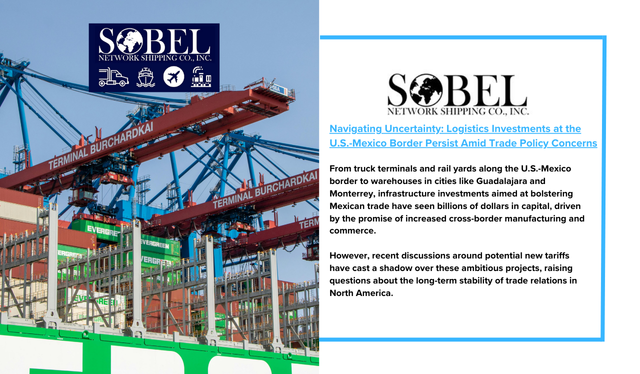From truck terminals and rail yards along the U.S.-Mexico border to warehouses in cities like Guadalajara and Monterrey, infrastructure investments aimed at bolstering Mexican trade have seen billions of dollars in capital, driven by the promise of increased cross-border manufacturing and commerce.
However, recent discussions around potential new tariffs have cast a shadow over these ambitious projects, raising questions about the long-term stability of trade relations in North America. Despite this uncertainty, logistics operators remain steadfast in their commitment to border investments, confident in the enduring value of nearshoring trends and the growing demand for cross-border manufacturing.
Logistics companies point to a variety of factors fueling the nearshoring boom, from labor cost advantages to supply chain efficiencies, emphasizing that these drivers go beyond temporary trade policy shifts. Many firms have expanded warehousing and transportation infrastructure to accommodate the anticipated growth in trade, with operators expressing confidence that these investments will yield returns over the long term.
One of the most significant developments in recent years is the creation of a single freight railroad network connecting Mexico, the U.S., and Canada, a result of a $31 billion merger in 2023. This 20,000-mile network facilitates seamless trade across the region, linking key ports and industrial hubs and supporting the expanding flow of goods between the three countries.
Trade data underscores the growing importance of Mexican manufacturing. The U.S. imported $475 billion in goods from Mexico in 2023, a 5% increase from the previous year and a 69% rise over the past decade. While some apprehensions linger over the potential for tariffs tied to broader geopolitical issues, logistics firms and manufacturers are positioning themselves to adapt to evolving trade policies.
For example, operators have increased cross-border warehousing capacity in strategic locations such as Laredo and El Paso. This includes new, larger facilities designed to support the rising demand for goods produced in Mexico. Such expansions reflect optimism about the long-term viability of nearshoring, even in the face of tariff-related uncertainty.
Governments are also playing a crucial role in bolstering trade infrastructure. Mexico has pledged significant investments, such as a $2.7 billion plan to expand the Port of Manzanillo on the Pacific Coast, aiming to double its container capacity by 2030. These efforts signal a commitment to supporting the growing trade network and reinforcing Mexico’s role as a critical manufacturing hub.
Experts in the logistics industry note that while tariff threats could lead some companies to reconsider production locations, many remain drawn to Mexico’s cost advantages and proximity to U.S. markets. They argue that even a significant tariff hike would not fundamentally alter the calculus for companies benefiting from the region’s labor and logistics advantages.
In response to the challenges and opportunities presented by shifting trade dynamics, logistics operators continue to innovate and invest. For instance, new trucking routes and intermodal services connecting Mexico with the U.S. Southeast and Midwest are being developed to strengthen cross-border supply chains.
Ultimately, while trade policy uncertainty may pose challenges, the broader trends driving nearshoring and cross-border commerce remain robust. As logistics operators adapt and expand their capabilities, the U.S.-Mexico trade relationship is poised to continue growing, underscoring the resilience and strategic importance of investments in this critical region.


